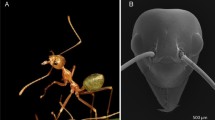Summary
A survey is given of recent work on physical aspects of sensory processes. The reasoning which leads to the generally recognized view that one rod of the retina is excited by only one quantum of light is given in par. II. In par. IIIa summary is given of the papers byHecht andVan der Velden on the number of rods which must be struck in order to obtaina sensation of light. Par. III describes the role of the quantum character of light at higher intensities (de Vries), where it sets a limit to intensity discrimination and visual acuity. The influence of Brownian movement on the process of hearing is discussed in par. VI. It is found that the Brownian movement of the inner ear is close to the threshold actually observed (de Vries), whereas the Brownian motion of the air at the eardrum (seeSivian andWhite) is below the audible threshold. The role of the Brownian movementin the sense cells is described in par. VII; the results are used for an analysis of the mechanism of hearing (see alsode Vries); evidence is obtained that electric voltages are generated in the tectorial membrane (the well-known cochlear microphonics) and that they play an important part in the mechanism of energy transfer to the sense cells (similar voltages were also derived from the cupolæ in the lateral lines of fishes by the present author). Finally some physical arguments are sumarized againstYeagley's theory of bird navigation.
Similar content being viewed by others
References
N. Raskevsky, Mathematical Biophysics (University of Chicago Press, Chicago, Ill., 1938) und Arbeiten verschiedener Autoren in: Bull. Mathematical Biophysics.
H.A. Van der Velden, Physica11, 179 (1944); Ophthalmologica111, 21 (1946) (englische Übersetzung der vorigen Arbeit); J. Opt. Soc. Am.37, 908 (1947).
E. Ludvigh undE. F. McCarthy, Arch. Ophthalm. (Chicago)20, 36 (1938).
Hl. de Vries, Nature158, 303 (1946).
S. Hecht, J. Gen. Physiol.25, 819 (1942).
H. A. Van der Velden, l. c..
Hl. de Vries, Physica10, 553 (1943). Siehe auchA. Rose, J. Opt. Soc. Am.35, 196 (1948).
Hl. de Vries, Physica10, 553 (1943).
S. S. Stevens undH. Davis, Hearing (John Wiley and Sons, New York, 1938).
G. von Békésy, Akust.8, 67 (1943);6, 1 (1941).
G. W. Steward, J. acoust. Soc. Am.2, 325 (1931).
W. E. Kock, ebenda7, 56 (1935);8, 23 (1936);9, 129 (1937).
D. Gabor, Nature159, 591 (1947).
L. J. Sivian andS. D. White, J. Acoust Soc. Am.4, 288 (1933).
Hl. de Vries, Physica14, 48 (1948).
Hl. de Vries, Nature161, 63 (1948).
R. H. Fowler undS. A. Guggenheim, Statistical Thermodynamics (Cambridge University Press, 1939), p. 529.
H. Broda, C. F. Goodeve undR. J. Lythgoe, J. Physiol.98, 397 (1940).
Donald R. Griffin, Ruth Hubbard undG. Wald, J. Opt. Soc. Am.37, 546 (1947).
Hl. de Vries, Physica erscheint demnächst.
E. J. Bowen, Chemical Aspects of Light (Clarendon Press, 1946).
Hl. de Vries, Nature161, 63 (1948).
Hl. de Vries, erscheint demnächst in Acta oto-laryngologica.
Hl. de Vries, Physica14, 48 (1948).
Inzwischen hat HerrJ. Bleeker sie auch von den Bogengangsampullen von Tauben abgeleitet (Klinik für Ohrenheilk., Groningen [Direktor Prof. Dr.E. Huizinga]).
Ich verdanke Herrn Prof. Dr.S. Dijkgraaf den Hinweis auf die für diese Versuche besonders geeigneten Tiere.
Y. Zotterman, J. Physiol.102, 313 (1943).
K. S. Cole undH. J. Curtis, J. Gen. Physiol.22, 649 (1937)
H. L. Yeagley, J. Applied Physics18, 1035 (1947).
G. Ising, Ark. Math. Astrophys.32 A, no. 4 (1946).
W. H. Thorpe undD. H. Wilkinson, Nature158, 903 (1946).
Author information
Authors and Affiliations
Rights and permissions
About this article
Cite this article
de Vries, H. Die Reizschwelle der Sinnesorgane als physikalisches Problem. Experientia 4, 205–213 (1948). https://doi.org/10.1007/BF02155365
Published:
Issue Date:
DOI: https://doi.org/10.1007/BF02155365




